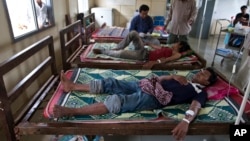Cambodia has reported only one death from malaria in 2016, down from nearly 400 a decade ago.
Huy Rekol, director of the National Center for Parasitology, Entomology and Malaria Control (CNM), said the figures showed a drop of 53 percent in overall reported malaria cases compared with 2015, from 51,262 to 24,237 last year.
Rekol said the patient who died of malaria in 2016 contracted the blood disease in Thailand and was brought to Cambodia for treatment.
“The patient was affected in Thailand and sent to Cambodia with a serious condition and died at hospital after 40 minutes,” he said.
Rekol said that the data was “collected from all health care providers, both public health facilities and the private sector, including communities under the national surveillance system.”
In 2006, there were 396 reported deaths from malaria, which had dropped to 18 by 2014.
The decline, Rekol said, was due to improved treatment and the use of new drugs called artesunate plus mefloquine.
“Last year, Cambodia switched to use the new drug [for malaria]. As a result, we were able to ensure no deaths,” he said. “We have our strategy to study and research on malaria disease and the drug. Cambodia and also the world considers drug resistance a big issue,” Rekol added.
The figures provided by Rekol were backed up separately by Dr. Benoit Witkowski of the Pasteur Institute, who said the findings were “credible” and a “positive step”, and Yves Bourny, country director of the Malaria Consortium.
Bourny said the consortium had recorded no reported deaths from malaria last year in its regions of focus: Pailin, Stung Treng, Ratanakkiri and Preah Vihear provinces.
“It’s a very encouraging sign although there are still some pockets where malaria is significantly present,” he said.
The World Health Organization (WHO) similarly has recorded an 84 percent decline in malaria-related deaths since 2012, however, malaria continues to be transmitted in 21 of the country’s 25 administrative regions.
Other countries in the region, such as Vietnam and Myanmar, have also seen significant improvements, according to the WHO.
In January last year the Cambodian government launched a new five-year plan to eliminate P. falciparum malaria by 2020 and P. vivax malaria by 2025.
The worst-affected regions are in the north-east near the borders with Vietnam and Laos.
The apparent success of the malaria eradication program will be welcome news for CNM, which has been plagued by years of corruption scandals in the misuse of malaria prevention funding and large “commissions” paid to CNM directors for the allocation of procurement contracts paid for by the Global Fund to Fight AIDS, Tuberculosis and Malaria.
Bourny of the Malaria Consortium said that there were still challenges to face regarding coverage in remote areas of the country, as well as access to treatment for migrant workers.









